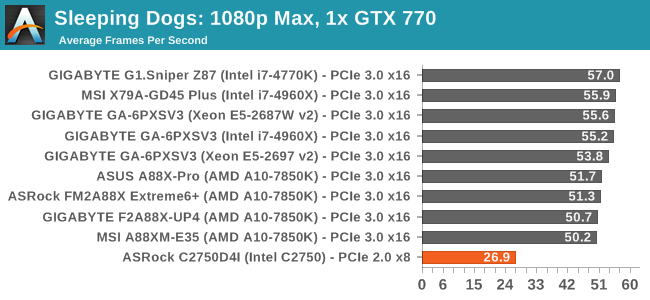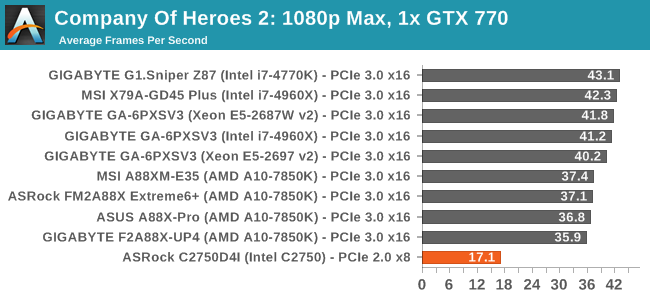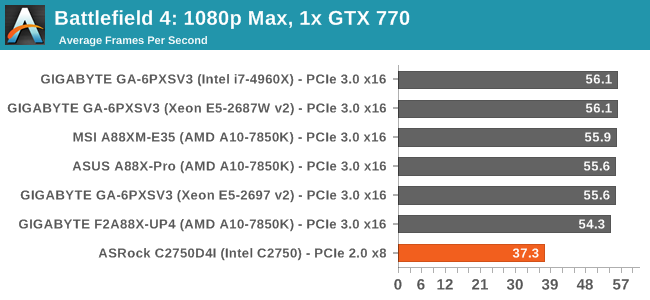ASRock Rack C2750D4I Review: A Storage Motherboard with Management
by Ian Cutress on April 29, 2014 9:00 AM EST- Posted in
- Motherboards
- Storage
- Atom
- ASRock
- Silvermont
- Enterprise
- server
- Avoton
Sleeping Dogs
Sleeping Dogs is a benchmarking wet dream – a highly complex benchmark that can bring the toughest setup and high resolutions down into single figures. Having an extreme SSAO setting can do that, but at the right settings Sleeping Dogs is highly playable and enjoyable. We run the basic benchmark program laid out in the Adrenaline benchmark tool, and the Xtreme (1920x1080, Maximum) performance setting, noting down the average frame rates and the minimum frame rates.

| Sleeping Dogs, 1080p Max | ||
| NVIDIA | AMD | |
| Average Frame Rates | ||
| Minimum Frame Rates | ||
Company of Heroes 2
Company of Heroes 2 also can bring a top end GPU to its knees, even at very basic benchmark settings. To get an average 30 FPS using a normal GPU is a challenge, let alone a minimum frame rate of 30 FPS. For this benchmark I use modified versions of Ryan’s batch files at 1920x1080 on High. COH2 is a little odd in that it does not scale with more GPUs with the drivers we use.

| Company of Heroes 2, 1080p Max | ||
| NVIDIA | AMD | |
| Average Frame Rates | ||
| Minimum Frame Rates | ||
Battlefield 4
The EA/DICE series that has taken countless hours of my life away is back for another iteration, using the Frostbite 3 engine. AMD is also piling its resources into BF4 with the new Mantle API for developers, designed to cut the time required for the CPU to dispatch commands to the graphical sub-system. For our test we use the in-game benchmarking tools and record the frame time for the first ~70 seconds of the Tashgar single player mission, which is an on-rails generation of and rendering of objects and textures. We test at 1920x1080 at Ultra settings.

| Battlefield 4, 1080p Max | ||
| NVIDIA | AMD | |
| Average Frame Rates | ||
| 99th Percentile Frame Rates | ||













85 Comments
View All Comments
Marquis - Tuesday, April 29, 2014 - link
Nevermind, reading comprehension FTW. The other two are mentioned later....bombshelter - Tuesday, April 29, 2014 - link
Your comment about the reason for using the PLX switch is wrong. First, the PEX8608 is an 8-lane switch and they are using it in a x4 (from CPU) to 4 x1s (to PCIe end-points) topology. The Avoton CPU actually has a total of 16 PCIe lanes, but can only bifurcate to 4 controllers. So the real reason they are using the PLX switch is to be able to have more than 4 PCIe end-points connected to the CPU. There will be no performance degradation or sharing of bandwidth due to the presence of the PLX switch since there is an equal number of lanes going into it from the CPU as as there are end-points connected on the downstream side.Ian Cutress - Tuesday, April 29, 2014 - link
Aha, yes my interpretation of the chipset diagram was a little off. Going to update the review.chang3d - Tuesday, April 29, 2014 - link
Supermicro has two similar board with a few differences of SO-DIMM, USB 3, 4 NICs, and 6 sata headers. It's also cheaper. I think the features of this board is much better than this ASRock board.http://www.newegg.com/Product/Product.aspx?Item=N8...
ddriver - Tuesday, April 29, 2014 - link
Is it just me or was this review an extremely bad match to that product? What about NAS performance, which undoubtedly will be one of the major selling points? Instead we get gaming on a product as far from gaming as it gets. And content creation?Ian Cutress - Tuesday, April 29, 2014 - link
According to users on several forums, this board has been the focus of many different types of build. I've done a brief analysis here of usability and interface, but Ganesh is our storage guru and has all the equipment for storage related tests, so I'd rather leave that in his court for a follow-up review rather than fumble through them myself.ddriver - Wednesday, April 30, 2014 - link
No offense, but you have reviewed a rake as a back scratcher :)With such massive storage capacity, dual gigabit onboard, up to 64 GB of ECC ram - computational performance is irrelevant, this product is all about throughput. While it may be viewed as somewhat beneficial to get concrete numbers, yet after all the numbers only confirm this product ain't neither about gaming nor about content creation, so if anything the review is useful at proving its uselessness, which makes it technically useful - which is quite a nice paradox ;)
LastQuark - Monday, May 5, 2014 - link
It's not you. This is perfect to me for what this board is intended for - virtualization, NAS, home web server, backup, even good enough for a Plex or XMBC server. The review made it seem like it is for HTPC and gaming which it is not.DuckieHo - Tuesday, April 29, 2014 - link
Drop the AST2300 for management.Drop BMC/SMB.
Drop IPMB.
Drop TPM.
Drop COM port.
Reduce fan ports (6 PWM to 4 PWM).
Drop a SATA controller (12 ports to 8 or 10).
Increase the size of the heatsink and/or add a fan.
Drop the price in half for a consumer version please!
Rick83 - Tuesday, April 29, 2014 - link
There's a quad-core version of the same board at 3/4 the price. That should be enough for most home users. It's also a 14W part, so has less cooling needs.